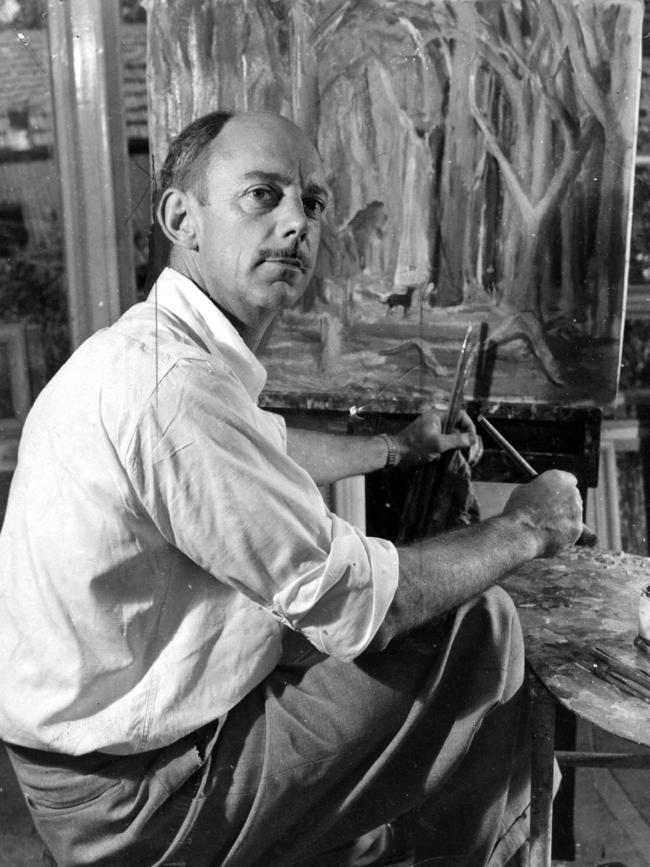Rachel Griffiths’ quest to find stolen Archibald winning portrait
Actress Rachel Griffiths is fronting a documentary in search of the 1958 Archibald Prize winning painting by artist William Pidgeon, which mysteriously disappeared in 1997.

Arts
Don't miss out on the headlines from Arts. Followed categories will be added to My News.
Rachel Griffiths is on the trail of a missing painting. And The Sunday Telegraph is right behind her quest to retrieve a piece of newspaper’ history — and to celebrate the centenary of the Archibald Prize for portraiture.
The Academy Award-nominated actress is fronting a three-part documentary about the Archibald, to be screened on the ABC ahead of a major Archibald retrospective opening on June 5 at the Art Gallery of NSW.
An intriguing chapter in Griffiths’ series, produced by Mint Pictures, is about a painting by artist William Pidgeon, whose Daily Telegraph illustrations and cartoons made him a household name from the 1940s until his death in 1981.
The subject of Pidgeon’s painting was Ray Walker, a legendary chief subeditor of The Daily Telegraph when the paper was still in the hands of the Packer family.
This painting isn’t any old daub. It won the 1958 Archibald Prize.


The trouble is, the picture hasn’t been spotted since 1997 when it mysteriously disappeared from The Journalists Club near Central Station, Sydney. When a painting measures 116cm by 95cm, disappearing isn’t easy.
Rachel Griffiths is convinced the painting of Walker is in someone’s house.
“I think a small group of people know exactly where it is,” Griffiths told the Sunday Telegraph.
She has a theory the painting was pinched as a prank and was ritually nicked from the houses of an inner circle.
“I like to think that it’s kind of in memory of how (Walker) was remembered. You know, he’s a ratbag, and so they’d steal it so you’d turn up for a dinner party and there he’d be, and they’d be like ‘oh how did you get it?’,” she said.
“So either the subject was dearly loved, it’s a historical prank, or it’s just a bloody good painting.”
Griffiths urges whoever has the painting to return it anonymously.
“We just need to tell them that no one’s going to prison,” Griffiths said.

This brings up the subject of legal ownership. With The Journalists Club folding in 1997, the painting’s ownership is by no means clear. The artist’s son, Peter Pidgeon, is staking his claim and said he would gift it to the National Portrait Gallery or similar institution.
William Pidgeon signed his commercial work “Wep”.
He was determined to win the Archibald, and in 1958 he did it for the first time with his oil painting of Ray Walker.
He won the Archibald twice more, painted Diggers overseas in World War II, illustrated John O’Grady’s classic Nino Culotta books including They’re A Weird Mob and encouraged a 15-year-old Brett Whiteley in his art.
Rachel Griffiths adores the portrait of Walker.
“You could feel the rapport, and I love that he had painted him bursting out of his shirt, well fed and quite sodden,” she said. “It has that great sense that the sitter is mid flight in a story.”
Pidgeon was commissioned to paint Walker by The Journalists Club, where Walker was president. After it won the Archibald, the portrait hung in the club’s dining room for decades until 1997 when the club went into liquidation and the painting simply disappeared.
Its last recorded sighting, outlined by the late cartoonist Tony Rafty in a 2003 letter to Wep’s son Peter Pidgeon, the painting was being packaged up to go to a storage facility.
It was never seen again, and its whereabouts remain shrouded in mystery and questions. Who took it, and why? It couldn’t have been for monetary gain. Such a famous painting could never be offered for public sale, because every art expert would be alerted to its shadowy history.

Art Gallery of NSW curator Natalie Wilson, who is in charge of the Archibald centenary exhibition, wonders whether the painting could have been sold by the liquidators to pay off the club’s debts.
But Ferrier Hodgson liquidators’ former senior executives including Peter Walker, and Andrew Love who is a major arts supporter, said they had no memory of the painting or its fate.
The funny thing is, the painting had already been stolen twice before. In 1988 Peter Pidgeon was working overseas when Dorothy rang to tell him the painting had gone missing from The Journalists Club for a few days before being returned. Then, in August 1996, the painting was again stolen from the club, along with another one.
“The apparent thief clearly had an attack of the guilts and contacted my mother,” Peter Pidgeon said.
Dorothy instructed the mystery caller to leave the paintings in the commuter shed at the Northwood ferry wharf. Instead, the paintings were dumped outside her home in Northwood Ave. They were fingerprinted by the police and returned to the club, which reportedly valued the Walker portrait at $15,000.
When the Walker portrait disappeared in 1997 so too, reportedly, did the club’s visitor’s book with signatures including the Pope and Alfred Hitchcock.
Griffiths is positive Wep’s prize-winning portrait is out there waiting to be found.
“I don’t think a painting that’s been three times stolen is destroyed, because it’s been too coveted,” she said.
As for what Wep would have said, “he’d probably be able to tell you who took it”, Peter Pidgeon said.
As an older man, his eyesight failing, Pidgeon penned art critiques for the Sunday Telegraph. In 1979 he was hit by a car near his Northwood home and died two years later.





